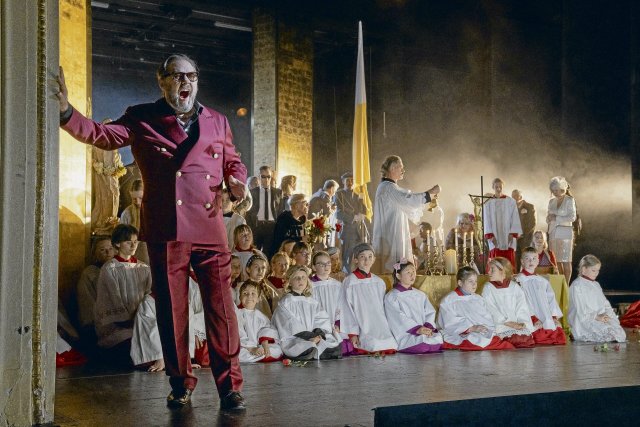A stroke of luck in terms of singing and play: Andreas Jäpel as the power-drunk police chief Scarpia
Photo: Bernd Schönberger/Staatstheater Cottbus
When the Cottbus choir, singers and directing team come on stage to bow in the strong final applause after this “Tosca”, they all collapse into each other in a completely disorderly manner. Again and again. Armin Petras is not interested in the “applause order” (a kind of sacred cow for many directors); apparently it was not rehearsed once. Not so important, you could say, the premiere has already taken place!
But it says a lot about this evening: strong singers, strong choirs (several), a strong orchestra, strong stage design, but direction that can be described as half-hearted. Does Armin Petras lack empathy for “Tosca”?
nd.DieWoche – our weekly newsletter

With our weekly newsletter nd.DieWoche look at the most important topics of the week and read them Highlights our Saturday edition on Friday. Get your free subscription here.
To be allowed to stage this opera once in your life and not give everything you have and then some? “Tosca” obviously doesn’t suit Petras, who likes to freely vary classical material and create fluid transitions between yesterday and today. But the plot and musical sequence of an opera are strictly defined, and the direction is in a corset. The path does not lead to the right or left, but only in one direction: increasing the expression, clarifying the inner drama within the given sequence.
While “La Bohème” was still a romantic artist’s story in which its creator Giacomo Puccini was about “harvesting tears,” “Tosca” is a brutal political drama in which there is no escape for those involved. “Until now we were gentle, now we want to be cruel,” said Puccini about his work, which premiered in Rome in 1900. The four main actors are all dead in the end. No reason to celebrate? Yes, the audience at the premiere celebrated the truthfulness of the work, but critics were irritated and even defensive.
How ugly this story is, on the battlefield of power, art and love they are all slaughtered. That’s why the genre name “Verismo” was introduced especially for “Tosca”, which means showing truth in all its absoluteness even when it becomes ugly, almost unbearable. That’s why in “Tosca” you can see the path (parallel and yet completely different to that of Richard Wagner) towards musical drama. The singers here are actors: anyone who only sings well is out of place.
Jan Pappelbaum has built “Tosca” a stage that precisely hits the nerve of both the overarching basic conflict of power and art and the locations of the action specified in the libretto. Brownish tiled walls that open up in the background, revealing dangerous black holes from which remnants of the wall protrude like steles.
What’s new about “Tosca” is that it is an explicitly political drama. Cesare Angelotti, a former consul of the Roman Republic, is held prisoner in Castel Sant’Angelo, but he manages to escape. He appears in the church where Mario Cavaradossi is painting a picture of the Magdalene and receives help from him. The police chief Scarpia also comes to the church and suspects Cavaradossi of complicity, and the jealous singer Floria Tosca also appears, who in turn is the object of the police chief’s desire. The backdrop to the scene is the Battle of Marengo in 1800. The false news spreads that Napoleon was defeated, but then we learn of Napoleon’s victory over the Austrians. Cavaradossi’s jubilation over this convicts him of being an enemy of the state in the eyes of the police chief.
Angelotti, who unfortunately only has a few appearances, is sung and played excellently by Alexander Trauth. The tenor Alexey Sayapin as Cavaradossi, who has a big aria in the first act, has a very powerful voice, although initially in a somewhat metallic way that lacks the soft tones. But then, as he continues, he also manages to give a shocking vocal expression to the martyrdom he has suffered. And baritone Andreas Jäpel as power-drunk police chief Scarpia? He is a stroke of luck both in his singing and in his playing, which carries this production over all the shoals.
And there are quite a few of them. On the one hand, Petras relocates the action to the Balkans in the 1990s. All mafia civil servants here wear sunglasses and Hawaiian shirts. Of course the text remains the same. But you can do that: contradictions are part of dramaturgical visualization. However, the inclusion of a mute person who observes the events and occasionally even hands out the murderous tools is completely unnecessary.
The orchestra under the direction of Alexander Merzyn begins stormily, almost hastily, and only at the end of the first act with the magnificently sung Te Deum from the opera – together with the children’s and youth choir – does an ominous, heavy silence become noticeable, which is always present here and has something of a mechanism of destruction.
The third main character of the opera is of course Floria Tosca. The American soprano Elena O’Connor has already sung this role in Wiesbaden and Dortmund. Vocally strong, but she shows weaknesses in the game. She can’t get past the appearance of the character (costumes: Cinzia Fossati), which she portrays as an elegant diva – her clothes, which have been changed several times, trigger a murmur in the audience. Suddenly there is too much bel canto instead of verismo on stage, and the life-and-death battle that develops with Scarpia turns into a fatal dalliance.
But where is the director who would have to tell his highly talented leading actress at this point that every step and every arm movement in her confrontation with Scarpia at the climax of the second act must have a meaning and that it must not be empty gestures of embarrassment?
He is not present. You really have to blame Petras for the fact that this scene doesn’t seem really worked through (or even thought through). What’s the point of Tosca’s exuberant, triumphant dance with Cavaradossi, since Tosca already has a murder on her mind? That overstates the importance of the pass Scarpia gave her.
In comparison, look at the recording of the Franco Zefferelli production of the second act of “Tosca” available on YouTube, Covent Garden in London, 1964. What concentrated determination of Tosca, who was presumed to be defenseless, not to hand herself over to the imperious Scarpia. The final step is her murder of the dictator, who also destroys her herself. A completely unpretentious Maria Callas at the early end of her career, already physically weak and turning what was left of her vocal power into expression, shaken by her absolute seriousness.
This catharsis is not present in a Cottbus “Tosca” evening that is worth seeing and listening to. The weak, the artists and intellectuals with their dreams of a different life, are not defenseless against the politically powerful, who are always capable of violence. You can resist.
Next performances: April 19th, June 2nd and 27th
www.staatstheater-cottbus.de
Subscribe to the “nd”
Being left is complicated.
We keep track!
With our digital promotional subscription you can read all issues of »nd« digitally (nd.App or nd.Epaper) for little money at home or on the go.
Subscribe now!
